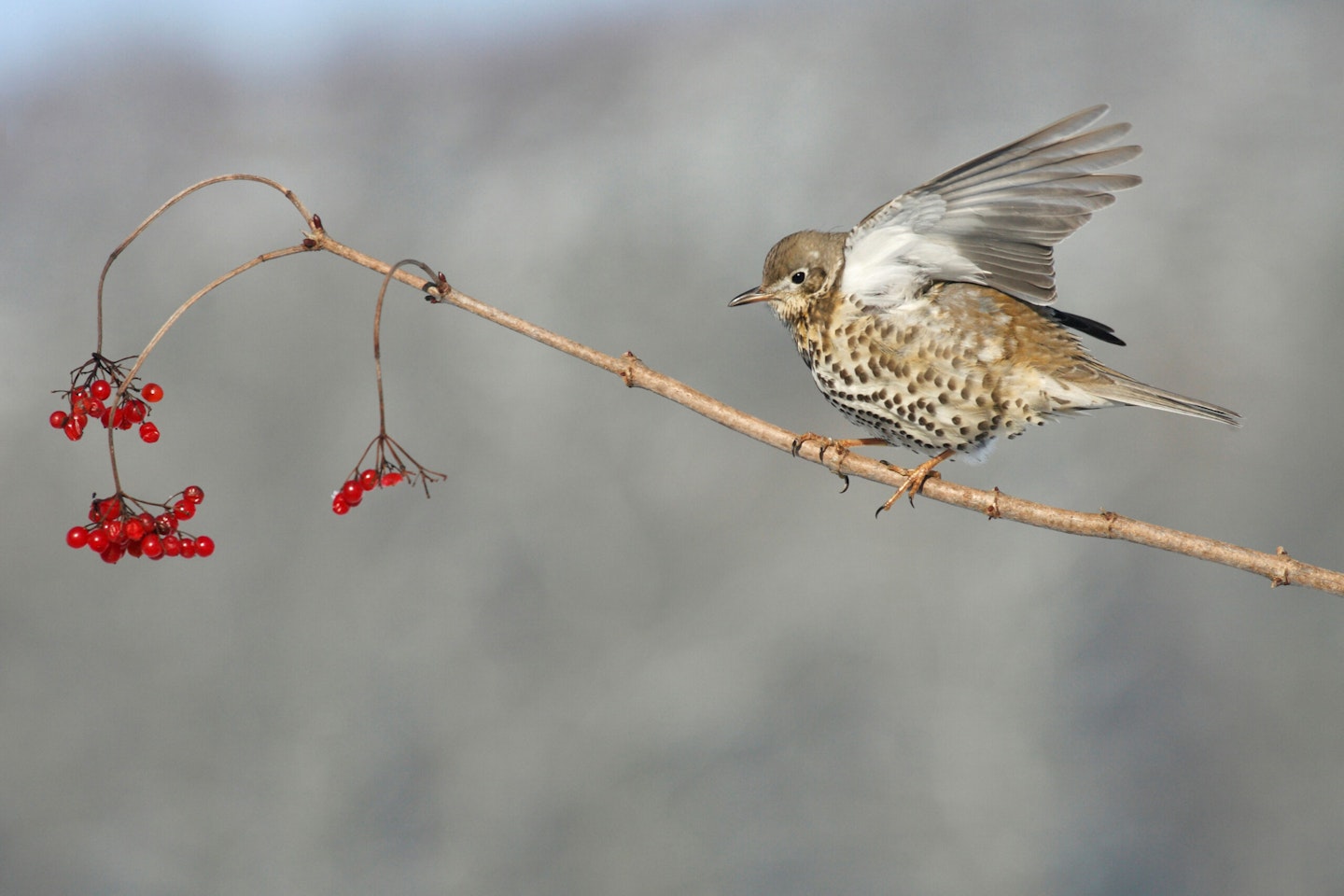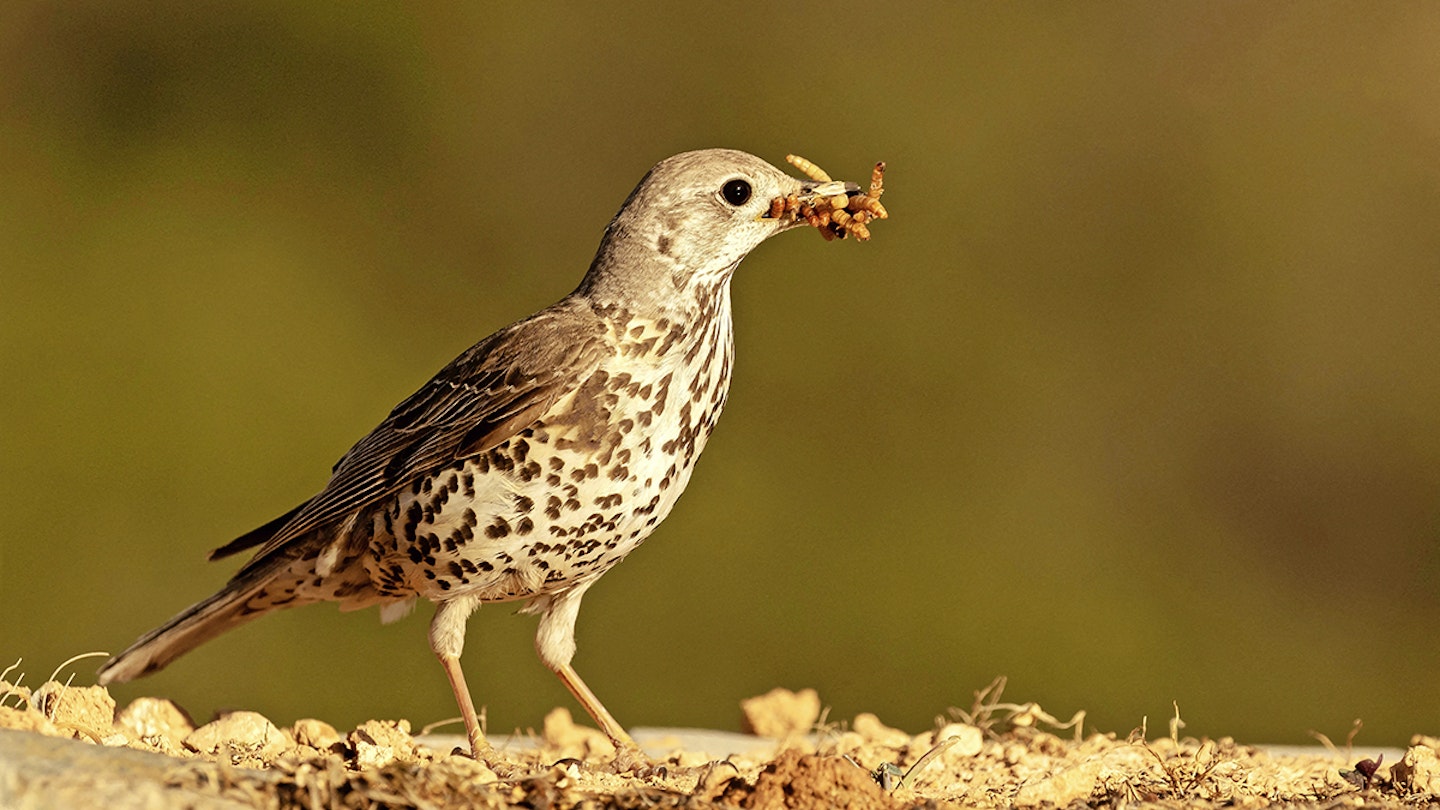Scientific name: Turdus viscivorus
Length: 26-29cm
Wingspan: 42-48cm
UK numbers: 170,000 pairs
Habitat: Woodland, parks, mature gardens
Diet: Fruit, invertebrates
It was a tweet from a follower that prompted me to remember. I cannot recall the exact location, but the feeling of surprise comes back strongly. It was one of those warm summer days when the green of the trees had noticeably faded, and the shade slumbered to the crooning lullaby of Woodpigeons, their ‘coos’ as fulsome and soft as expensive bed linen.
By the edge of the forest, the Rowan berries had begun to come out, so new and shiny that you thought any hungry bird arriving would have to remove the plastic packaging first. Out from one such tree, I disturbed a Mistle Thrush, which gave off the gentle telling-off version of its rattling alarm call, irritated rather than in panic.
That, as you’ll be aware, is hardly headline news – “Mistle Thrush in tree to eat berries.” But then a couple more flew out and, from a second tree across the heath, three more tut-tutted in a rattling way and made off, with that distinctive undulating flight they have, a gentle up and down, like a young children’s rollercoaster. Within a few moments, a whole group of about
15 birds had evacuated the Rowan grove like rats from a flood, flip-flopping over the treetops to a site free of pesky humans.
I remembered thinking: “What are all these Mistle Thrushes doing together?” And that brought me back to James Gilbert’s tweet. He had seen 30-40 Mistle Thrushes together, all in one group, which is a large number by any standards. The standard view of a Mistle Thrush for any birder in Britain is to see one or a pair, plus the odd family party in the breeding season. These are generally regarded as the most territorial and solitary of our thrushes. So, what were so many of these aggressive and typically private birds doing together?
Dig into its lifestyle and you will find that the Mistle is something of a contrary thrush. After all, it is perhaps most famous for its habit of singing when everything else, including other thrushes, has fallen silent. It often sings loudly in the afternoon, as if it were intentionally trying to be different. It sometimes sings in flight, quite unlike a Blackbird or Song Thrush. It begins its singing season in November, long before most other species are contemplating keeping a territory. And, perhaps most pertinently, it sings in poor weather, a trait that has given rise to the evocative country name of Storm Cock.
I have heard them on winter afternoons when the clouds are grey to bursting and the wind would seem able to rip a high-perching bird from its song-post. But the Storm Cock sings on, not quite the band on the Titanic, but a wondrous show of defiance all the same. And the melancholy tone of the Mistle Thrush’s song just adds to the tumultuous atmosphere.

Gregarious hermits
So what, then, if a solitary thrush becomes suddenly sociable? It seems that, if it wants to, a Mistle Thrush will do what it likes, and there are no obvious rules. So, after breeding, many Mistle Thrush family parties wander open country together. Sometimes these parties coalesce. There is also some evidence that fledged juveniles of different families may form their own same-aged flocks. Whatever their origin, some Mistle Thrushes do indeed become particularly sociable in late summer, and sometimes into the early autumn, but these larger flocks don’t last long. And it is equally clear that not every individual joins in this glut of friendliness. You can find a lone Mistle Thrush in late summer and autumn, just as you can find one during the rest of the year. You cannot easily pin down what an individual will do.
And, intriguingly, a similar but even stronger dichotomy occurs in the later autumn, when the Mistle Thrush population really does divide into two very separate camps.
At this time of the year, about the time that the birds start singing, some individuals or pairs become very attached to a small territory, bearing several trees or shrubs with long-lasting berry stocks, such as Holly, Hawthorn or, indeed, Mistletoe.
The rest of the population becomes free-ranging and virtually nomadic, not keeping a defended territory but probably ranging over a specific, fairly large area. Without ever wishing to be controversial, I will name the territorial birds Remainers and the nomadic birds Leavers.
Leavers and Remainers
The Remainers, working either as singletons or pairs, spend months defending ’their’ patches of berries. They don’t spend all day eating them, but instead feed on invertebrates on the ground nearby, only taking berries when they need to. These birds are protectionists and set up border controls, attacking any bird that might arrive to deplete the berry stocks. If you hear very loud and angry rattling calls from Mistle Thrushes in October and November, this is what is going on. These Remainers aim to keep their berry stocks intact through the winter, acting as a living larder.
This doesn’t always work. Flocks of migrants or other immigrant workers, such as Redwings and Fieldfares, sometimes arrive en masse and overwhelm the Remainers. This can be disastrous and sometimes Remainers starve to death; others turn into Leavers.
The Leavers, meanwhile, simply wander from place to place feeding on invertebrates or spare berries as they please. They operate no border controls of their own, although they might violate others’.
Presumably, in times of great hardship, their strategy fails and they succumb while Remainers survive. The dichotomy in behaviour ensures that sometimes one strategy and then the other is the most successful.
Unexpected nesting partners
Almost every birdwatcher would also assume that Mistle Thrushes always nest solitarily. They begin nest-building famously early, in March, well before the leaves are on the trees and they may have eggs in the same month. They also nest higher up, and in larger trees, than other species of thrush, usually at least 5m above the ground, and often well above that. They bring their natural aggression into the defence of the nest; they are big-bodied, loud and fierce, and are good at repelling predators.
In some parts of the Mistle Thrush’s range, they enter into a curious arrangement with another, completely unrelated bird, the Chaffinch. The birds have the same habitats, but the nests are so often close together that the proximity is thought to be intentional. The value to the Chaffinch is obvious; Mistle Thrushes are highly effective at nest defence, and should another bird nest in their space, the neighbours will benefit, too.
The value to the Mistle Thrush is thought to be the Chaffinch’s vigilance. In the breeding season, Mistle Thrushes almost always feed on the ground, while Chaffinches spend much time up in the trees, so presumably the latter have a good all-round view of danger.
In some parts of their range, although not in the UK so far as is known, this thrush enters into an even more unexpected nesting arrangement – with its own species. Studies in Denmark have shown that some Mistle Thrush pairs gather in small colonies, usually of just two or three pairs, but sometimes nesting in the same tree. About a third of breeding pairs in the study were found to be loosely colonial.
Of course, that leaves two-thirds that aren’t. However, it seems as though, if you look carefully into the life of this fiercely independent bird, it has an unexpectedly sociable streak.
Where to see them
Though never abundant, Mistle Thrushes have a wide distribution across the UK, shunning only the highest, most treeless mountains, and the bleak Outer Hebrides.
